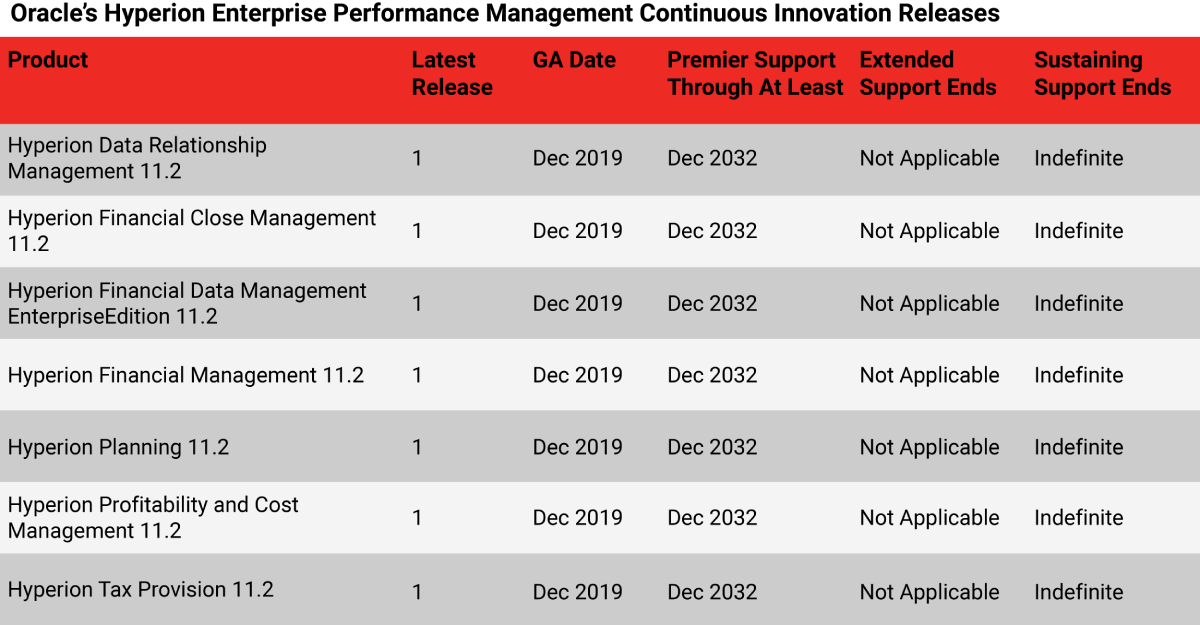Oracle Hyperion Enterprise Performance Management (EPM) solution is one of the most prominent financial close solutions in the market as it helps enable the office of finance departments to work remotely, automate manual processes, and shorten close cycles.
Oracle EPM is especially valuable as the COVID-19 pandemic forced many financial teams to either move entire workloads online or work in a remote operation model, with many needing to access EPM mission-critical processes quickly and efficiently.
In a continued plan to support the investments made by Oracle Hyperion clients, Oracle announced that Oracle Hyperion, as part of the Oracle Applications Unlimited program, would continue to receive on-premises support through at least 2032. This is particularly good news as it will help clients avoid the risks of third-party support, or worse yet, being desupported completely.
To benefit from the continued support offered by Oracle through the Applications Unlimited program, Hyperion clients need to be on what’s dubbed as Continuous Innovation releases, which for Hyperion means release 11.2.7.
The tech giant has committed to perform annual reviews about the viability of continuing to extend Premier Support for an additional year, which comes to show that on-premises solutions aren’t going anywhere. Yet.
Moving to the cloud will ultimately be the endgame for all Oracle Hyperion instances, but by being supported, you can take your time and carefully plan the migration without exposing your software to added costs and unwanted vulnerabilities that could result in millions of dollars lost or a complete halt to your business operations.
In this blog, we’re going to describe each of these options available to your Oracle Hyperion EPM so you can make the best decision for your unique business needs.
Protecting Oracle Hyperion EPM with Premier Support
Under the umbrella of Premier Support, Oracle Hyperion EPM gets to enjoy the ongoing delivery of applications and underlying technology stack updates for 11.2 without ever having to worry about performing another major upgrade again. Oracle Hyperion EPM 11.2 is the long-term support release and will have its Premier Support extended on a yearly basis as deemed by Oracle. Hyperion EPM 11.2 clients can expect:
- Application updates. Application code analogous to the 11.2.7 updates made available on a yearly basis. Updates are cumulative and will combine bug fixes and new features in a consolidated patch set that can be seamlessly applied with Online Patching.
- Technology stack updates. Refresh of the Oracle Fusion Middleware platform technologies underlying the Oracle Hyperion EPM System to allow customers to get new versions of the technology stack without upgrading Oracle Hyperion EPM system applications code.
Securing Premier Support for your Oracle Hyperion EPM helps you confidently maximize and expand your existing investments, with more than enough time to plan your cloud migration thanks to a stable and predictable long-term support policy. Covered Hyperion EPM products will have new functionality delivered as updates to the existing long-term release, and major upgrades will no longer be needed to access new features and capabilities. Also, fixes and updates are cumulative and will be made available as users upgrade to the most current release version.
On-premises solutions are alive and well, so you can rest assured that your Oracle Hyperion EPM will not have Premier Support discontinued for on-premises applications prior to 2031.
Here’s a snapshot of Hyperion’s continuous innovation releases:

Hyperion components such as Hyperion Financial Reporting, Foundation Services, Smart View for Office, and more, are supported according to the above-mentioned timeline.
Supported Paths for EPM Release 11.2.7
You are capable of moving to Oracle EPM 11.2.7 from the following releases, as specified by Oracle:
- Release 11.2.6: You can use the Apply Update option in EPM System Installer when moving from the 11.2.6 release to 11.2.7 release.
- Release 11.2.5: You can use the Apply Update option in EPM System Installer when moving from the 11.2.5 release to 11.2.7 release.
- Release 11.2.4: You must first upgrade to release 11.2.5 and then use the Apply Update option in EPM System Installer when moving from the 11.2.4 release to 11.2.7 release.
- Release 11.2.3: You must first upgrade to release 11.2.5 and then use the Apply Update option in EPM System Installer when moving from the 11.2.3 release to 11.2.7 release.
- Release 11.2.2: You must first upgrade to release 11.2.4, then upgrade to release 11.2.6, and then use the Apply Update option in EPM System Installer when moving from the 11.2.2 release to 11.2.7 release.
- Release 11.2.1: You must first upgrade to release 11.2.3, then upgrade to release 11.2.5, and then use the Apply Update option in EPM System Installer when moving from the 11.2.1 release to 11.2.7 release.
- Release 11.2.0: You must first upgrade to release 11.2.2, then upgrade to release 11.2.4, then upgrade to release 11.2.6, and then use the Apply Update option in EPM System Installer when moving from the 11.2.4 release to 11.2.7 release.
- Release 11.1.2.4: You must upgrade from release 11.1.2.4 to release 11.2.x. To upgrade existing applications, you must deploy the EPM System release 11.2.x software on a new machine, then migrate artifacts such as applications, metadata, and security from release 11.1.2.4 to the new deployment.
Keep in mind that the Oracle Hyperion EPM 11.2.7 upgrade, and all 11.2.x upgrades for that matter, is an out-of-place installation, which means that the software must be installed on new hardware.
Thanks to the Continuous Innovation model and the Applications Unlimited program, organizations who have Oracle Hyperion EPM on-premises have enough time to plan their successful migration to the cloud, as long as they are on Premier Support to ensure the ongoing protection and delivery of new updates, fixes, and security updates of their Hyperion EPM system.
Download our latest ebook, “Configuring Your System After Updating to EPM 11.2.7” for details on the post-upgrade system and manual configurations you need to perform after the successful upgrade project is finalized.

